Galapagos Species Database
The Galapagos Species Database shares the information about the species from our Natural History Collections.
Philornis downsi
Mosca Vampiro Aviar, Avian Vampire Fly
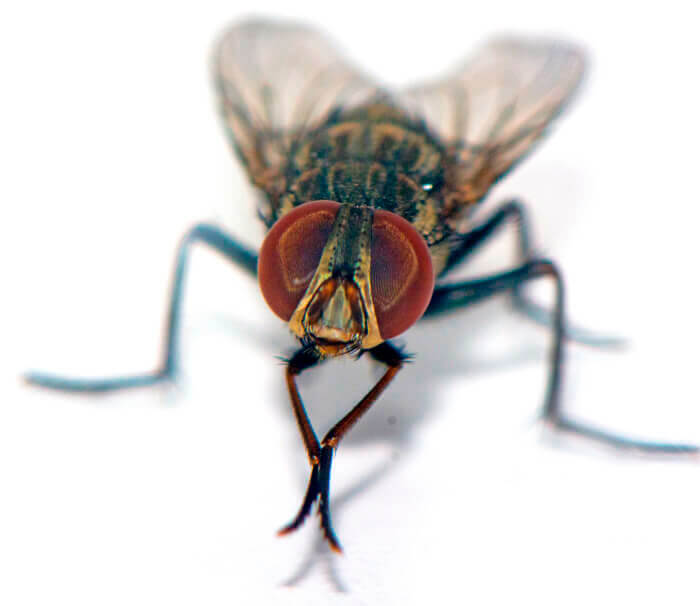
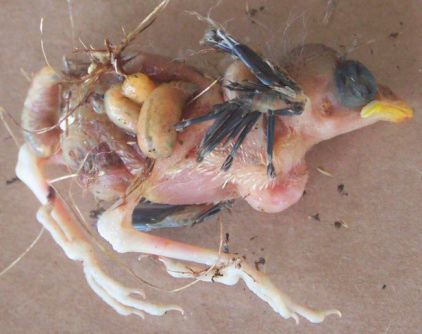
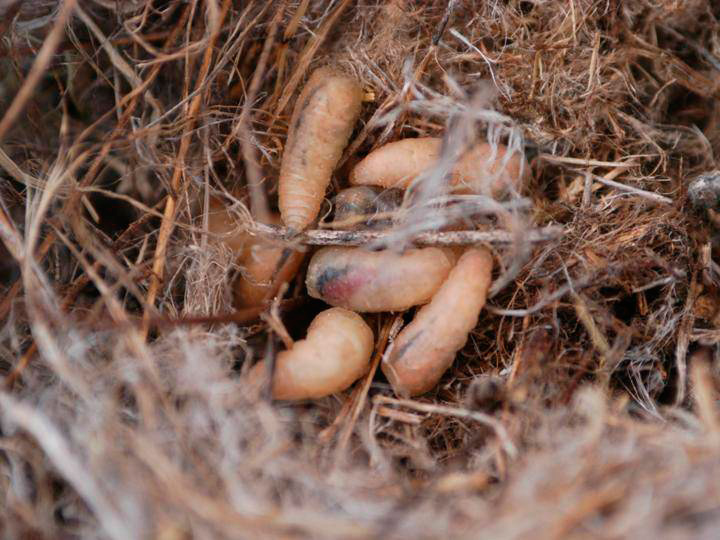
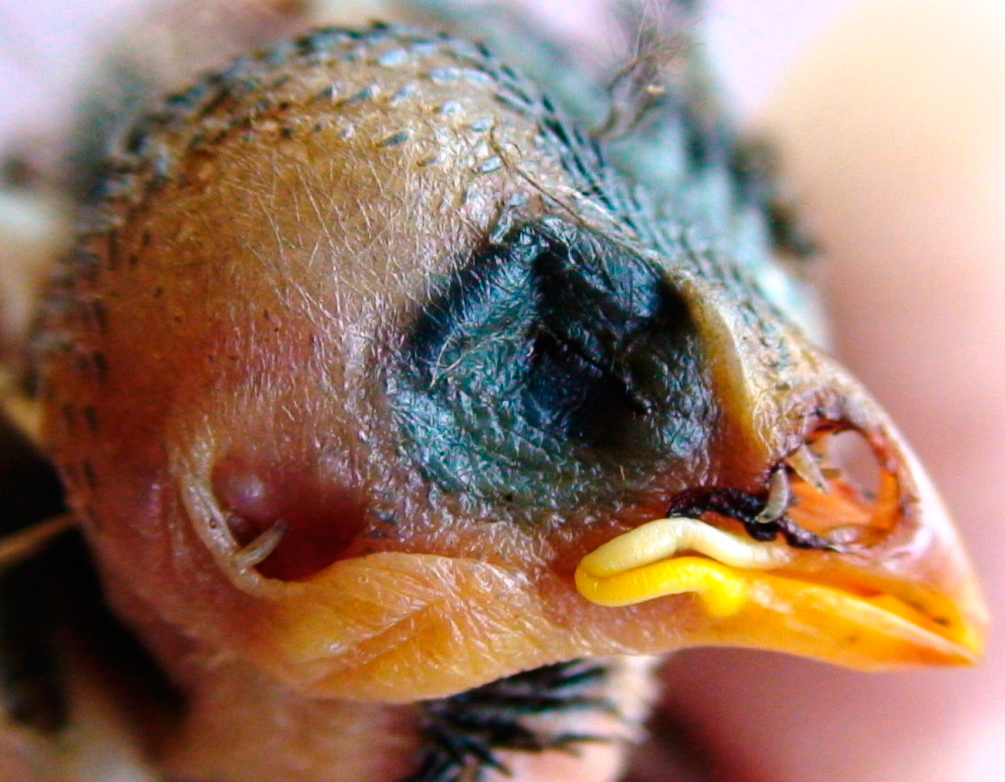

Similar in size and appearance to the common house fly, and usually dark in coloration. Male adults usually have yellow legs and eyes closer together, whereas females have darker legs. Female antenna plumose. Adult flies are free-ranging, eating fruits and nectar. They lay eggs in bird nests and the fly larvae feed on the blood and tissue of young chicks.
Larvae are free-living external parasites upon nestlings in bird nests (Dodge & Aitken 1968; Fessl et al. 2001), including Darwin’s finches.
Domain
Eukaryota
Kingdom
Animalia
Phylum
Arthropoda
Class
Insecta
Order
Diptera
Suborder
Brachycera
Family
Muscidae
Genus
Philornis
Species
downsi
Taxon category: Accepted
Syn: Philornis isla Couri 2000: 1.
Origin: Introduced - established
Year of first record: 1964
Mode of introduction: Accidental
Introduction Pathway: Stowaway
Subpathway: Hitchhiker on transport vehicles/cargo
Introduced status: Naturalized
Invasive status: Invasive
Impact in Galapagos: At least 16 endemic bird species, one native, and one introduced specie are attacked by P. downsi. The fly’s impact on birds is a serious threat especially to vulnerable and declining species. Philornis downsi parasitism has already been implicated in the decline of endemic, critically endangered species such as the mangrove finch (Camarhynchus heliobates) and the medium tree finch (C. pauper). In addition to direct mortality (sometimes up to 100% of hatchlings in a nest die from parasitism), studies have confirmed that surviving birds have reduced life expectancy due to deformed beaks, reduced growth rates, and anaemia. Philornis has a greater impact on bird species with small clutch sizes, e.g. tree finch species, than species with bigger clutch sizes.
Control History in Galapagos: At this point in time, there are no known techniques to effectively mitigate the threat of P. downsi. In spite of considerable efforts by the Charles Darwin Foundation (CDF) and collaborators there are still substantial gaps in the understanding of the life history and ecology of P. downsi, which has prevented the development of methods to control the fly. Because of this, an international workshop was held by the Galapagos National Park Directorate (GNPD) and CDF in February 2012 to bring together local and international experts to find a solution for the management of P. downsi. Control options that are being investigated include mass trapping using lures, biological control, and spot treatments of nests with low risk pesticides.
Preference for an altitude zone in Galapagos: Dry zone - humid zone
Habitat preferences: Found in most habitat types in the Galapagos, from the arid lowland to humid highland zones.
Substrate or host preferences: Larval hosts are mainly passerine birds, but also include Culiciformes.
Feeding type: Adults feed on fruit and nectar, and larvae are semi-hematophagous (blood and tissue feeding) parasites of birds.
Feeding preferences: Little is known about the feeding habits of adult flies. It is believed that they feed on fruits and nectar. In the laboratory they will feed on a variety of fruits and protein sources.
Trophic role: Zoopathogenous parasite
Reproduction mode: Exclusively sexual
Reproductive biology: Females lay their eggs in birds’ nests on the nest material surface or on nestlings. Fly eggs have also been found on the nasal openings (nares) of nestlings. The eggs hatch after 1-2 days and 1st instar larvae feed within the nestlings’ nares. The 2nd and 3rd instar stages live in the nest base and emerge at night to feed on the blood and tissues of nestlings either externally or within the nares. Larvae pupate in the nest base after about 7 days, and emerge as flies approximately 14 days later. Genetic studies have shown that female flies can mate with up to 5 males, but mating has not been observed in the nests or anywhere else in the field.
Distribution origin: Known from Trinidad & Brasil, but the native range is likely to be wider.
Distribution classification: Eutropical
Dispersal propagule: Philornis species are able to travel over large distances. In Galapagos, Philornis downsi are attracted to lights on tourist boats and may also have been dispersed by boats.
Natural enemies: In Galapagos four species of parasitic wasps have been reared from Philornis pupae (Spalangia endius, Brachymeria podagrica, B. cabira; and the eulophid Aprostocetus [Tetrastichinae]). There are no records of parasitoids of P. downsi in its native range; however, at least three species of wasps are known to parasitize Philornis species.
Associated species in Galapagos: Camarhynchus heliobates, Camarhynchus pallidus, Camarhynchus parvulus, Camarhynchus pauper, Camarhynchus psittacula, Certhidea olivacea, Coccyzus melacoryphus, Crotophaga ani, Dendroica petechia aureola, Geospiza fortis, Geospiza fuliginosa, Geospiza magnirostris, Geospiza scandens, Mimus melanotis, Mimus parvulus, Mimus trifasciatus, Myiarchus magnirostris, Pyrocephalus rubinus.
Map of specimen collection localities or observation records for this species in our collections database.
Distribution: Present on 15 islands: Baltra, Champion, Daphne Major, Fernandina, Floreana, Gardner (Floreana), Isabela, Marchena, North Seymour, Pinta, Pinzon, San Cristobal, Santa Cruz, Santa Fe, Santiago.
- Causton, C.E. Cunninghame, F. & Tapia, W. (2013) Manejo del parásito aviar Philornis downsi en las islas Galápagos: Un plan de acción colaborativo y estratégico. En: Galapagos Report 2011-2012. GNPS, GCREG, CDF and GC. Puerto Ayora, Galapagos, Ecuador.
- Causton, C.E. Cunninghame, F. & Tapia, W. (2013) Management of the avian parasite Philornis downsi in the Galapagos Islands: a collaborative and strategic action plan. In: Galapagos Report 2011-2012. GNPS, GCREG, CDF and GC. Puerto Ayora, Galápagos, Ecuador.
- Causton, C.E. Peck, S. B., Sinclair, B. J., Roque-Albelo, L., Hodgson, C. J. & B. Landry. (2006) Alien insects: threats and implications for the conservation of the Galapagos Islands. Annals of the Entomological Society of America, 99(1), 121-143.
- Causton, C.E. Fessl, B. (2022) Avian nest parasitic flies Philornis downsi and related species. Fowler's Zoo and Wild Animal Medicine. Chapter 82, pp. 529-533.
- Causton, C.E. Sevilla, C. (2008) Latest Records of Introduced Invertebrates in Galapagos and Measures to control them. Galapagos Report 2006-2007, CDF, GNP and INGALA, Puerto Ayora, Galapagos, Ecuador, p. 142-145.
- Couri, M. S. Tavares, M. T. & Stenzel, R. R. (2006) Parasitoidism of chalcidid wasps (Hymenoptera: Chalcididae) on Philornis sp. (Diptera: Muscidae). Brazilian Journal of Biology 66:553-557.
- Cunninghame, F. Ortiz-Catedral, L. & Fessl, B. (2012) Plan para la conservación de aves terrestres: Estrategias para revertir la disminución de las aves paseriformes en las Islas Galápagos. Informe Tecnico, CDF and GNPD.
- Cunninghame, F. Ortiz-Catedral, L. & Fessl, B. (2012) Landbird Conservation Plan: Strategies for Reversing the Decline of passerine birds on the Galapagos Islands. Technical Report, CDF and GNPD.
- Dudaniec, R.Y. Gardner, M.G. & Kleindorfer, S. (2009) Offspring genetic structure reveals mating and nest infestation behaviour of an invasive parasitic fly (Philornis downsi) of Galápagos birds. Biol. Invasions, DOI 10.1007/s10530-009-9464-x.
- Dudaniec, R.Y. Fessl, B. & Kleindorfer, S. (2007) Interannual and interspecific variation in intensity of the parasitic fly, Philornis downsi, in Darwin’s finches. Biological Conservation 30: 325-323.
- Dudaniec, R.Y. Kleindorfer, S. & Fessl, B. (2006) Effects of the introduced ectoparasite Philornis downsi on haemoglobin level and nestling survival in Darwin’s Small Ground Finch (Geospiza fuliginosa). Austral Ecology (2006) 31, 88–94, doi:10.1111/j.1442-9993.2006.01553.x
- Dudaniec, R.Y. Gardner, M.G. & Kleindorfer, S. (2007) Isolation, characterization and multiplex polymerase chain reaction of novel microsatellite loci for the avian parasite Philornis downsi (Diptera: Muscidae). Molecular Ecology Notes (2007), doi: 10.1111/j.1471-8286.2007.01900.x
- Dvorak, M. Fessl, B., Nemeth, E., Kleindorfer, S.M., & Tebbich, S. (2012) Distribution and abundance of Darwin ́s Finches and other land birds on Santa Cruz Island Galapagos: evidence for declining populations. Oryx 46:78-86
- Fessl, B. Sinclair, B.J. & Kleindorfer, S. (2006) The life-cycle of Philornis downsi (Diptera: Muscidae) parasitizing Darwin’s finches and its impacts on nestling survival. Parasitology 133: 739–747, doi:10.1017/S0031182006001089
- Fessl, B. Kleindorfer, S. & Tebbich, S. (2006) An experimental study on the effects of an introduced parasite in Darwin’s finches. Biological Conservation 127(1): 55-61.
- Fessl, B. Young, H. G., Young, R. P., Rodríguez-Matamoros, J., Dvorak, M. & Tebbich, S. (2010) How to save the rarest Darwin’s finch from extinction: the mangrove finch on Isabela Island. Philosophical Transactions of the Royal Society of London, Series B: Biological Sciences 365:1019–1030.
- Fessl, B. Tebbich, S. (2002) Philornis downsi - a recently discovered parasite on the Galápagos archipelago - a threat to Darwin's finches? Ibis 144: 445-451.
- Fessl, B. Couri, M.S. & Tebbich, S. (2001) Philornis downsi Dodge & Aitken, new to the Galapagos Islands (Diptera, Muscidae). Studia Dipterologic 8: 317-322.
- Fessl, B. Heimpel, G. & Causton, C. (2018) Invasion of an avian nest parasite, Philornis downsi, to the Galapagos Islands: colonization history, adaptations to novel ecosystems, and conservation challenges. In: Parker, P. (ed.). Disease ecology: Galapagos birds and their parasites. Disease Ecology. Social and Ecological Interactions in the Galapagos Islands. Springer, Cham. 213-266 pp. https://doi.org/10.1007/978-3-319-65909-1_9
- Galligan, T.H. Kleindorfer, S. (2009) Naris and beak malformation caused by the parasitic fly, Philornis downsi (Diptera: Muscidae), in Darwin's small ground finch, Geospiza fuliginosa (Passeriformes: Emberizidae). Biological Journal of the Linnean Society 98: 577-585.
- Huber, S.K. (2008) Effects of the introduced parasite Philornis downsi on nestling growth and mortality in the medium ground finch (Geospiza fortis). Biological Conservation 141: 601-609.
- Jiménez-Uzcátegui, G. Wiedendfeld, D.A. (2005) Philornis downsi ectoparasite: wild birds affected and distribution in Galápagos. XIX Annual Meeting of the Society Conservancy Biology. Universidade de Brasília. Brasilia DF, Brazil, pp. 103.
- Koop, J. A. H. Huber, S. K., Laverty, S. M. & Clayton, D. H. (2011) Experimental demonstration of the fitness consequences of an introduced parasite of Darwin’s finches. PLoS ONE, 6(5):e19706, doi: 10.1371/journal.pone.0019706.
- Leuba, C. Tebbich, S., Nemeth, E., Anchundia, D., Heyer, E., Mosquera, D., Richner, H., Rojas, M., Sevilla, C. & Fessl, B. (2020) Effect of an introduced parasite in natural and anthropogenic habitats on the breeding success of the endemic Little Vermilion Flycatcher Pyrocephlaus nanus in the Galápagos Journal of Avian Biology 51, doi 10.1111/jav.02438.
- Mosquera, D. Fessl, B., Anchundia, D., Heyer, E., Leuba, C., Nemeth, E., Rojas, M.L., & Tebbich, S. (2022) The invasive parasitic fly Philornis downsi is threatening the Little Vermilion Flycatcher on the Galápagos islands. Avian Conservation and Ecology 17(1):6. https://doi.org/10.5751/ACE-02040-170106.
- O'Connor, J.A. Sulloway, F.J., Robertson, J. & Kleindorfer, S. (2009) Philornis downsi parasitism is the primary cause of nestling mortality in the critically endangered Darwin's medium tree finch (Camarhynchus pauper). Biodiversity Conservation DOI 10.1007/s10531-009-9740-1
- Pike, C. L. Ramirez, M.I., Anchundia, D., Fessl, B., Heimpel, G.H., & Causton C.E. (2021) Nest visitation behavior of the avian parasitic fly Philornis downsi in the Galapagos Islands. Journal of Insect Behavior 34: 296-311. https://doi.org/10.1007/s10905-021-09789-7.
- Sinclair, B. J. (2023) An annotated checklist of the Diptera of the Galápagos Archipelago (Ecuador). Zootaxa, 5283, 1-102
- Sinclair, B.J. Peck, S.B. (2005) An annotated checklist of the Diptera of the Galápagos Archipelago (Ecuador). Charles Darwin Research Station, unpublished, 64 pp.
- Tavares, M.T. Stenzel, R.R. (2006) Parasitoidism of chalcidid wasps (Hymenoptera: Chalcididae) on Philornis sp. (Diptera: Muscidae). Brazilian Journal of Biology 66:553-557.
- Wiedenfeld, D.A. Jiménez-Uzcátegui, G., Fessl, B., Kleindorfer, S. & Valarezo, J.C. (2007) Distribution of the introduced parasitic fly Philornis downsi (Diptera, Muscidae) in the Galapagos Islands. Pacific Conservation Biology 13(1): 14-19.
You are welcome to download and use the information found in this page, acknowledging its source.
This page should be cited as follows:
"Galapagos Species Database, Philornis downsi", dataZone. Charles Darwin Foundation, https://datazone.darwinfoundation.org/en/checklist/?species=10067. Accessed 2 January 2026.
